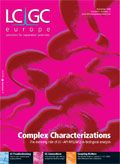Going Dutch
A look at some of the cutting-edge chromatography groups in The Netherlands
Research group: Associate Professor Teris A. van Beek, Natural Products Chemistry Group, Laboratory of Organic Chemistry, Wageningen University, Dreijenplein 8, 6703 HB Wageningen.

Dennis Flaherty/Getty Images
Research Focus: The activities of the group are focused on natural products chemistry/phytochemistry. A long-term research project has been the quality control of Ginkgo biloba, the most sold herbal medicinal plant in the world. New preparative and analytical methods using high performance liquid chromatography (HPLC), supercritical fluid chromatography (SFC) and thin layer chromatography (TLC) have been developed. The TLC method has found its way into several official Pharmacopoeia monographs. A current chemical ecological project is focused on identifying the structure of the sex pheromone of minute predatory wasps. Virgin females produce only a few picogrammes/hour and never more than 2 nanogrammes at any one time could be sampled by solid-phase microextraction (SPME), which requires chemical conversions at the nanogramme-scale prior to analysis by gas chromatography high-resolution mass spectrometry (GC–HRMS).
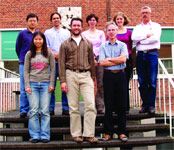
Recent projects include the development of comprehensive HPLC (LC×LC) for triacylglycerols and phenolic acids. This work focuses on combining efficient orthogonal separation systems for metabolomic studies and the analysis of complex samples. The use of ultra-performance liquid chromatogrpaphy (UPLC) columns in the second dimension is useful for this approach. To avoid the time-consuming isolation and individual bioassays of pure compounds, HPLC on-line detection of antioxidants and CYP450 inhibitors has been pursued. This has turned out to be a particularly successful line of research over the past 10 years. The antioxidant set-up has been taken over by many other groups.
The group's largest project at the moment is investigating more efficient production routes for natural plant-derived red and yellow dyes for textiles in cooperation with an industrial partner.
Enzymatic conversions play an important role in this project. Other projects include the synthesis of new monolithic affinity phases for the selective sample clean-up of disease markers in human plasma samples and the application of a three-phase microreactor for the small-scale sample preparation of alkaloids. If such a microreactor can be hyphenated to an extraction chamber or a detection technique, such as nanospray MS, rapid detection of alkaloids in minute samples will become a reality. The group is determined to ensure that natural products chemistry remains a modern and vibrant niche within the chromatography sector.
E-mail: teris.vanbeek@wur.nl
Research Group: Peter Schoenmakers, Wim Kok, Hans-Gerd Jannsen and Sjoerd van der Wal, Polymer-Analysis Group, Faculty of Science, University of Amsterdam, Nieuwe Achtergracht 166, 1018 WV Amsterdam.
The polymer analysis group (PAG) at the University of Amsterdam is a separation science group consisting of Peter Schoenmakers and Wim Kok, with Hans-Gerd Janssen (Unilever) and Sjoerd van der Wal (DSM) as part-time professors. Twelve PhD students are working in the group with another four conducting their research outside the institute. The laboratory is maintained by Petra Aarnoutse, Tom Aalbers and Peter Verschuren and contains numerous contemporary separation devices and detectors, including five new mass spectrometers. The group has been built on the solid foundations laid by Professor Hans Poppe, Dr Johan Kraak and — before them — Professor Josef Huber.
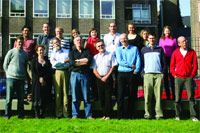
Research Focus: The group obtains significant funding from the Dutch Polymer Institute (DPI) and from the Dutch Nanotechnology programme (NanoNed). It also maintains strong ties with industry (e.g., Dow Chemical, AstraZeneca, Syngenta) and with chromatography suppliers.
Approximately one half of the projects focus on the separation of polymers of natural and synthetic origin, one third on novel separation media (such as chips and monoliths) and the remainder on various other separation problems.
Current strengths of the group include the separation of natural and synthetic macromolecules, the creation of novel separation devices and techniques, and the theoretical and practical aspects of multi-dimensional separations.
The professors in the group teach analytical chemistry, separations and statistics to undergraduate and graduate students in chemistry — including the highly successful MSc programme on Analytical Sciences (together with the Free University), as well as MSc students in forensic science and art science.
The group is heavily involved in the organization of the series of conferences on Hyphenated Techniques in Chromatography (HTC) and the Separation and Characterization of Natural and Synthetic Polymers (SCM). Peter Schoenmakers also contributes to the organization of the HPLC series of conferences and he is an editor of Journal of Chromatography A.
E-mail: p.j.schoenmakers@uva.nl
Research group: Professor Hans-Gerd Janssen, skill base chromatography and mass spectrometry, Unilever Food and Health Research Institute, Vlaardingen and University of Amsterdam, Polymer-Analysis Group, Amsterdam.
Research Focus: As part of Unilever's Research and Development division the group develops and applies chromatographic and mass spectrometric methods to support the research into new foods and home and personal care products. The company aims to develop healthier foods. Eliminating or reducing less-desirable food ingredients, such as salts, trans-fatty acids and sugars, fortifying foods with minerals and vitamins and incorporating functionally active molecules are key areas in Unilever's foods research that require analytical support.
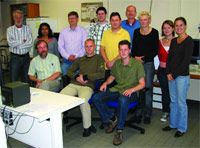
Detailed characterization of the main food ingredients, the fats and proteins, is vital for understanding the structural properties of new foods. Chromatographic methods such as normal-phase (NP) liquid chromatography × gas chromatography (LC×GC) and size exclusion chromatography × liquid chromatography (SEC×LC) are developed to characterize complex triglyceride mixtures and (aggregated) proteins. Comprehensive GC×GC was developed as a new tool for trans-fatty acid analysis.
The analytical requirements arising from Unilever's research into new functional ingredients are particularly challenging. New methods are needed to identify actives from complex natural extracts. Recently a method was developed to identify natural antioxidants present in edible oils and a two-dimensional LC method coupled on-line to biochemical activity detection was applied to detect and identify the structure of blood-pressure-lowering peptides in complex milk ferments. Numerous new methods have also been developed to monitor the uptake, metabolism and excretion of these new ingredients in vivo. Identification of metabolites using various LC– or GC–MS strategies or using metabolomics approaches is vital in this work.
Hans-Gerd Janssen holds a part-time chair at the University of Amsterdam in the polymer-analysis group headed by Peter Schoenmakers. His academic group focuses on the detailed characterization of (bio)macromolecules including proteins and polysaccharides. New techniques are developed to allow the extraction of more-detailed information from these biomacromolecules. These new techniques include both methods that look at the intact molecules, as well as techniques where the large molecules are first converted into smaller species that are more amenable to LC and GC. In particular the work on comprehensive methods such as size exclusion chromatography × reversed-phase liquid chromatography (SEC×RPLC), size exclusion chromatography (SEC) × Pyrolysis GC–MS (SEC×(Py)-GC–MS) and LC×LC–Py GC has been very successful. In addition to working on novel sample conversion- and separation methods the group also focuses on statistics and chemometrics to separate relevant from non-relevant information and to establish composition–structure–property relationships.
E-mail: Hans-Gerd.Janssen@unilever.com
Research group: Professor Hubertus Irth and Professor Cees Goojer, Department of Analytical Chemistry and Applied Spectroscopy, VU University Amsterdam, Amsterdam.
Research Focus: The analytical department is active in a broad spectrum of analytical chemistry research, with a focus on biomolecular analysis, led by Professor Irth, and applied spectroscopy, led by Professor Gooijer.
The biomolecular analysis group works on the development of novel analytical methodologies for the discovery and trace analysis of biologically relevant compounds such as drugs, metabolites, (bio)catalysts, biomarkers, therapeutic proteins, protein-drug adducts, with a particular focus on applications in therapeutic drug discovery.
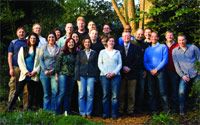
A major research line is dedicated to the development of analytical screening technologies based on liquid chromatography mass spectrometry (LC–MS) to measure simultaneously the chemical and biochemical characteristics of bioactive compounds. Both post-column biochemical detection coupled on-line to high performance liquid chromatography (HPLC) and preconcentration techniques based on affinity chromatography (AC) are employed for this purpose. Recent work in this area has included the development of affinity preconcentration techniques using his-tagged protein drug targets such as the α- and β-oestrogen receptor. Research in screening also involves the development of miniaturized analytical techniques such as microchip reactors and nanospotting coupled on-line to capillary and nano-HPLC.
In the area of protein analysis hyphenated techniques comprising immunoaffinity preconcentration, on-line digestion using immobilized or solution-phase enzyme reactors (using trypsin, pepsin and other proteases) and subsequent LC–MS analysis of marker peptides have been developed. Recent applications of this technique include the determination of covalent adducts of warfare agents to endogenous proteins as well as the trace analysis of human serum albumin (HSA) adducted to reactive intermediates of therapeutic drugs.
A third research line is devoted to the development of novel derivatization reagents to improve the selectivity and sensitivity of mass spectrometric detection. Recently, a novel, highly sensitive and selective derivatization agent, 4-(2-(trimethylammonio)ethoxy) benzenaminium halide (4-APC) has been described that allows the selective derivatization of compound classes, such as aldehydes and carbohydrates, that are difficult to detect using standard MS ionization techniques. One of the key features of 4-APC, a permanent positive charge, will significantly reduce ion suppression, increase ionization efficiency and is ideally suited for structure-specific MS–MS screening strategies in biological samples.
The applied spectroscopy group works in close collaboration with the Laser Centre VU (LCVU), which provides a unique infrastructure in the area of laser spectroscopy. The research is directed at the development/involvement of laser spectroscopic methods such as Raman spectroscopy (RS) and fluorescence (phosphorescence) spectroscopy (FPS) in a variety of modes for analytical chemistry and physical chemistry purposes. In addition an advanced technique called cavity ring down spectroscopy (CRDS) in liquid-state systems is currently under investigation.
In the field of steady-state fluorescence spectroscopy (SSFS) and RS main emphasis is paid to the on-line coupling with capillary electrophoresis (CE) and LC, to fully exploit the detection and identification potential of these spectroscopy modes. In fluorescence, attention is paid to both wavelength-resolved emission and deep-ultraviolet (UV) excitation, as well as polarization measurements and energy-transfer processes for structure elucidation purposes. High-resolution fluorescence techniques such as fluorescence line-narrowing spectroscopy (FLNS) are used to study protein–ligand interactions. In RS, both on-line coupling [using deep UV (resonance) Raman] and at-line coupling [using surface-enhanced (resonance) Raman] are investigated.
E-mail: irth@few.vu.nl
Research Group: Professor Thomas Hankemeier, Professor Jan van der Greef, Dr Heiko van der Linden, Dr Theo Reijmers and Dr Rob Vreeken, Analytical Biosciences, Leiden Amsterdam Centre for Drug Research, Leiden University, Leiden.
Research Focus: The overall aim of the research group is to develop innovative analytical tools for metabolomics-driven systems biology research for personalized health strategies. As metabolic processes are at the core of physiology and an excellent reflection of the phenotype, metabolomics is ideally positioned to distinguish between health and disease. The group develops innovative metabolite-profiling methods to determine signalling compounds such as endogenous, metabolites and peptides in biofluids, tissues and cells, which are often in very low abundance.

Novel and generic liquid chromatography (LC) and/or electrodriven separation methods, hyphenated with mass spectrometry (MS), are used for quantification and identification. Accurate quantification of metabolites with MS is often hampered by co-elution as a result of ionization suppression effects, especially with electrospray ionization (EI). By gaining a better understanding of the physico-chemical mechanisms of EI, novel methods and devices based on micro/nanotechnology are developed to improve the sensitivity and quantification of electrospray mass-spectrometry (EI-MS).
Multi-dimensional separation methods are being developed to resolve complex metabolite and peptide mixtures. Microfluidic technology is being explored as a prospective tool as it allows the efficient coupling of separation modes. Microfluidics also has the advantage that once all the relevant steps are integrated in chip-based formats, analysis of minute sample volumes, such as biopsies and CSF of mice models, is possible. This allows the creation of an analytical platform for the analysis of biological phenomena at the level of an individual, living cell. Nano- and microfluidics technology is essential for liquid-handling at the nanolitre to femtolitre scale. The identities of many metabolites profiled by these various analytical methods are not yet known. To further elucidate these structures, one of the research lines is focused on algorithm and rule-based identification strategies using LC/CE–high-resolution multi-stage spectra.
To address the complex data obtained with these tools in (pre)clinical studies, advanced multivariate data analysis methods are developed and applied. This ultimately leads to a better understanding of the underlying biochemical processes responsible for metabolic syndromes (cardiovascular, obesity, diabetes type 2) or neurological diseases.
E-mail: hankemeier@lacdr.leidenuniv.nl
HPLC 2025 Preview: Fundamentally Speaking (Part 1)
May 13th 2025Michael Lämmerhofer from the Institute of Pharmaceutical Sciences, University of Tübingen, Germany, spoke to JFK Huber Lecture Award winner of 2024 Torgny Fornstedt, professor in analytical chemistry and leader of the Fundamental Separation Science Group, Karlstad University, Sweden, about his pioneering work in high performance liquid chromatography (HPLC) with a focus on fundamentals and industrial applications.
Reversed-Phases for LC Deliberately Doped with Positive Charge: Tips and Tricks for Effective Use
May 13th 2025In this month's edition of LC Troubleshooting, Dwight Stoll and his fellow researchers discuss both the benefits (improved peak shape/loading) and challenges (excessive interaction) associated with charge-doped reversed-phase (RP) columns for both analytical and preparative separations.
Determining Ways to Protect Honeybee Colonies with GC–MS
May 13th 2025A study conducted by the Agriculture Research Centre of Giza, Egypt, and Jilin Agricultural University in China, evaluated the efficacy of stinging nettle extract, nettle smoke, and formic acid in the controlling of Varroa mites, a major threat to honeybee colonies, with a focus on mite infestation reduction, honeybee mortality, and biochemical responses. Gas chromatography–mass spectrometry (GC–MS) was used to identify key bioactive compounds in the stinging nettle extract.

.png&w=3840&q=75)

.png&w=3840&q=75)



.png&w=3840&q=75)



.png&w=3840&q=75)
